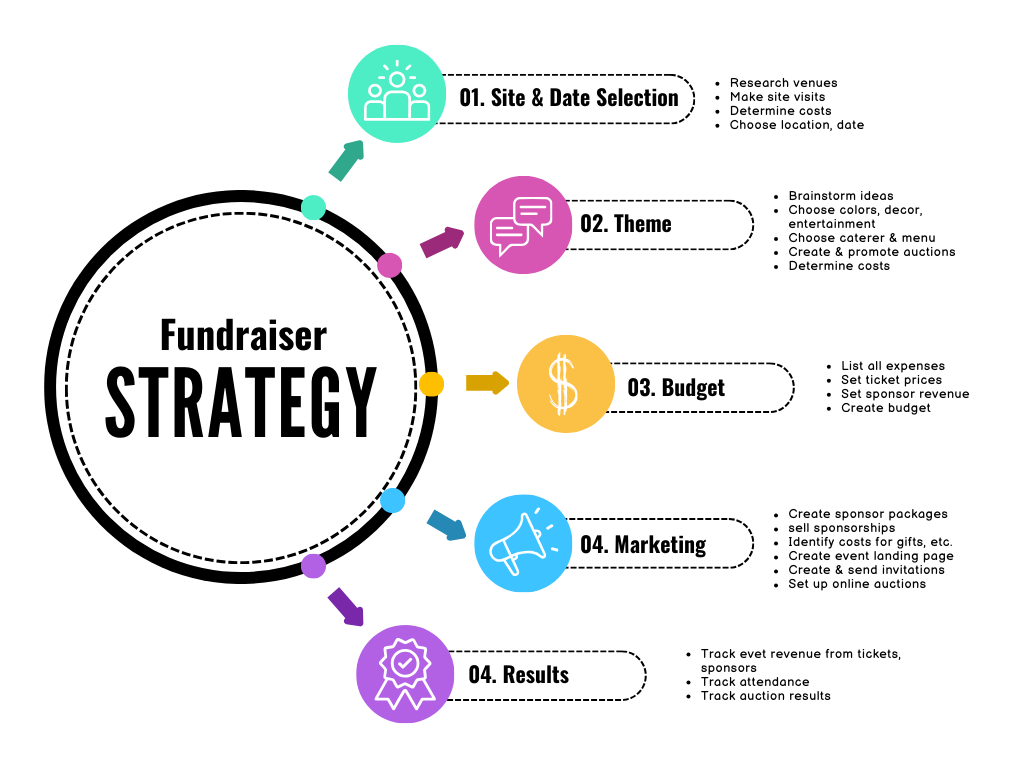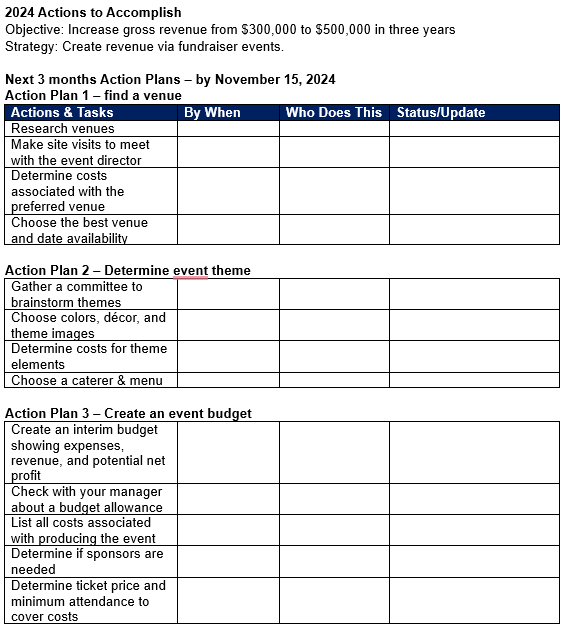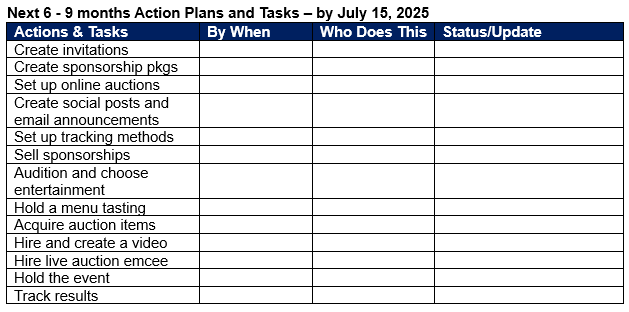Writing A Business Plan – Part 3
Developing Your Strategies and Action Plans
For many clients, crafting their Strategies and Actions can be challenging. Sometimes it’s difficult to wrap your mind around how they fit into the business plan. The Vision, Mission, Values, and Objectives (goals) are pretty straightforward. The Strategies and Actions perhaps less so. But these are critically important to helping you achieve the objectives.
Strategies, Actions, and Tasks Connect the Dots.
Think of your strategies and actions as the tasks you need to achieve by a certain date to complete an objective. These connect the dots between where you are today and the future goals you want to achieve.
For example, in our second blog article where we discussed setting objectives, one objective might be to increase gross revenue from $300,000 to $500,000 in three years. We’ll need several strategies to achieve that revenue goal. Let’s assume our business is a charitable organization and we use annual fundraisers to help generate revenue.
That strategy might be worded as follows: “Create revenue via fundraiser events.”
To execute this strategy, we’ll have several actions that must be accomplished before the event takes place. Here are just a few things that have to happen:
- Select a location and date
- Determine the event theme
- Create a budget
- Determine if there will be silent, online, and live auctions
- Select the entertainment
- Choose the caterer
- Create and send invitations
- Promote the event via social media and email
- Hold the event
- Track results
Those 10 items are the actions to be accomplished for the strategy of raising $50,000 via a fundraiser event in 2025. Each action has its own due date and lists of tasks that must be accomplished before that strategy is completed. As you start assigning due dates to the actions and tasks, you may see that to accomplish one action, a prior one must be completed.
For example, selecting a location may require site visits to meet with the catering event director. The location may be a hotel or a clubhouse or a unique location like a museum or golf course. Until you identify the location and the cost to hold your event there, you can’t complete your budget, the third action on your list.
The same holds true for the event theme. That may require a committee meeting to brainstorm ideas and research the costs associated with creating the ambiance you want – colors, decorations, attendee gifts, etc. Those costs will be added to the budget as part of the overall expenses for producing the event.
Once you’ve determined all the costs associated with producing the event, you may find it necessary to offset those costs with sponsors. Even those have costs associated with them since sponsors expect special treatment such as free tickets, free drinks, gifts, etc. You will need to create different sponsorship levels with their own set of recognition and gifts depending on the amount of money being donated. In this situation, you have another set of actions and sub-actions tied to finding and securing sponsors.
All of these activities are the actions (or tasks) that need to be accomplished by varying dates to achieve the objective of raising $50,000 via a fundraiser event in 2025. These actions with their respective due dates drive your daily activities leading up to the event. They connect the dots between where you are today (planning the fundraiser) and achieving the end goal of raising $50,000.
If we continue with the same 1-3 year horizon we’ve used for the prior two blog articles, then you write your strategies and actions as follows:
Business building objective to accomplish by a future date, PLUS 8-10 strategies that describe how that objective will be done, PLUS specific Actions and Tasks to accomplish for each strategy.
Using the fundraiser example.
The strategy is to use fundraisers to generate revenue. This supports the higher-level objective of growing gross revenue from $300,000 to $500,000 in three years. You then create several action plans to achieve that strategy.
Action Plan 1 is to select a location and a date for a fundraiser vent. The tasks to accomplish that are:
- Research venues
- Make site visits to meet with event directors
- Determine costs associated with the preferred venue
- Choose the best venue and date availability
Action Plan 2 is to determine the event theme by October 31, 2024 Those tasks might include:
- Gather a committee to brainstorm themes
- Choose colors, décor, and theme images
- Research and select vendors to supply materials
- Determine costs associated with theme elements
Action Plan 3 is to create an event budget by November 30, 2024. The actions tied to that might include:
- List all costs associated with producing the event
- Set a ticket price and minimum attendance needed to cover costs
- Set fundraising goals
- Set sponsorship goals to offset expenses
- Create a budget showing expenses, revenue, and potential net profit
Use a Rolling Actions Calendar
Use the strategies and actions with their respective due dates to help you prioritize your daily work. You might list them out as tasks to achieve in 3 months, 6 months, 12 months, etc. When you complete a task in the 3-month category, move one up from the 6-month category. That way you are always working on a manageable list of tasks to move your plan forward.
For example, using the event strategy with its applicable action plans and tasks from above, your rolling task list might look something like this below:
As you work on these actions and tasks, you begin to check off the ones that have been completed and begin working on the next set. These help you prioritize your daily work to ensure you are making progress towards achieving the fundraising strategy that supports the overall objective of “Increasing gross revenue from $300,000 to $500,000 in three years.
Obviously, you will have other activities that fill your day, including unplanned emergencies to tend to. However, if you keep a running list of tasks such as this, keep checking off the completed ones, starting the next, and follow up with team members to track their progress, you should make progress towards your end goal.
Contact us if you have questions about this approach.



